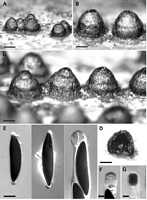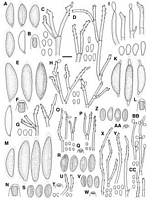|
 Rosellinia palmae Rosellinia palmae
BiostatusPresent in region - Indigenous. Endemic
Images (click to enlarge)
Caption: Fig. 23 Rosellinia palmae. A-C, Stromata; D, Vertical section of stroma; E, Ascospores, 2nd
showing part of germ slit on the upper part (arrow); F, Ascus apical | 
Caption: Fig. 12 A-D, Rosellinia novae-zelandiae, PDD 43205: A, Ascospores, last one immature; B,
Ascus apical ring; C, Conidiophores and conidia on the host (PDD 16422); D, Conidiophores
and conidia in culture (PDD 42074); E-H< |
Article: Petrini, L.E. (2003). Rosellinia and related genera in New Zealand. New Zealand Journal of Botany 41(1): 71-138 (http://www.rsnz.org/publish/abstracts.php).
Description: Subiculum not seen. Stromata (500)530 ± 27(550) µm high, (550)80 ± 21(600) µm wide ( n =
5), conical with a large, wide conical top, black, solitary or crowded in small groups,
sometimes up to three fused together, some of them with stromatal margin, confluent over the
whole substrate in crowded areas. Ostioles undifferentiated. Ectostroma 25-50 µm thick,
black. Entostroma absent in mature material. Perithecia remaining attached to the stromata.
Ascus apical rings (10.5)11.5 ± 0.7(12.5) µm long, upper width 7.6-8.6 µm, lower width
6.7-7.7 µm (n = 5), J+, dark blue. Ascospores (38.4)42.2 ± 2.3(47) µm long, (9.1)10.3 ±
0.7(11.5) µm wide (n = 30), inequilaterally ellipsoidal, dark brown, with straight germ slit
extending over the whole spore length, both extremities and convex side surrounded by a
slimy sheath, 2-3 µm thick and 5-6 µm wide at spore ends.
ANAMORPH: Unknown.
Habitat: HOST: Rhopalostylis baueri var. cheesemanii.
MATRIX: Rachides.
Notes: ETYMOLOGY: According to the host family.
NOTES: Rosellinia palmae is characterised by conical stromata with distinctive tops and
undifferentiated ostioles. Ascospores are mid-sized with two slimy caps and a long germ slit.
Only the type collection is known and does not show a subiculum. The ascus apical ring,
however, is typical of Rosellinia spp.This species differs from R. radiciperda by stromatal
characters, the absence of a subiculum in mature material, and ascospores without a cellular
appendage. In addition to stromatal characters, R. palmae can be distinguished from R.
longispora by smaller ascospores and ascus apical rings and from R. novae-zelandiae by
larger ascospores of different shape without a cellular appendage. Rosellinia lamprospora
Syd. resembles R. palmae; however, the former has larger, pear-shaped stromata and larger
ascospores lacking a slimy sheath (L. E. Petrini unpubl. data). R. formosana has stromata of a
similar shape as R. palmae, but they are larger and the ascospores are more than twice as long
(Ju & Rogers 1999)
|